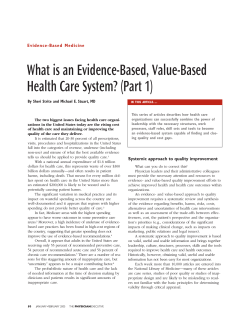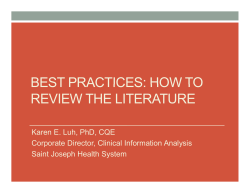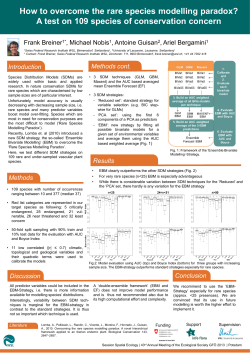
How to Develop, Implement and Evaluate a Longitudinal, Evidence- Pharmacy Students
How to Develop, Implement and Evaluate a Longitudinal, Evidencebased Medicine Curriculum for Pharmacy Students Connie Kraus, PharmD, BCPS Denise Walbrandt Pigarelli, PharmD, BD-ADM Gerri Wanserski, MA, MLS University of Wisconsin-Madison Why Should We Teach our Students to use an Evidence-based Approach in Answering Clinical Questions? • Phenomenal, steadily increasing amount of information • Increasing demands on pharmacist time leaves minimal time for searching • Learning traditional evidence-based medicine and information mastery approaches to literature searching improves the likelihood of finding best quality literature and saves time • Framework for life-long learning 2 Should We Focus on Teaching a Course or Teaching a Skill? • Commitment to teaching a skill across the curriculum rather than a one-time course • Frequent use of skill supplemented with “just-intime” teaching • Collaboration across faculty, clinical instructors (preceptors) and librarians is a key feature 3 1 Our Evidence-based Medicine Curriculum Map DPH-1 - Hands-on introduction to core health databases from librarian with course writing assignment requiring peer-reviewed literature on a public health topic DPH-2 - Two lectures in EBM - 1.5 hour case-based, librarian-facilitated handson lab with writing assignment - Semester course on drug literature review - 1.5 hour instructor/librarian facilitated lab reviewing clinical query writing assignment 4 Our Evidence-based Medicine Curriculum Map DPH-3 – Librarian-facilitated colloquium reviewing EBM principles, resources, and search strategies – Two written clinical inquiry assignments generated from introductory pharmacy practice experience – 1.5 hour librarian/instructor facilitated lab with group clinical inquiry on an infectious disease scenario DPH-4 – Advanced pharmacy practice experiences with 7-8 evaluated and scored clinical inquiries 5 What is Evidence-based Medicine? And…What are the Key Concepts in Teaching Pharmacy Students? “The conscientious, explicit and judicious use of current best evidence in making decisions about the care of individual patients.” David Sackett 1997 6 2 Key Concept: Approaches to Answering a Clinical Question Ebell M. Information at the point of care: answering clinical questions. J Am Board Fam Pract 1999;12:225-235 7 Key Concept: Relevance—Are the Outcomes Important to our Patients? • Patient-Oriented Evidence that Matters (POEMS) – Mortality – Morbidity – Quality of Life – Cost Shaughnessy AF, Slawson DC, Bennett JH. Becoming an information master: a guidebook to the medical information jungle. J Fam Pract 1994; 39:489-500. 8 • • • • • • • • Key Concept: Information Varies in Quality, Currency, and Level of Evidence -- Important to Know the Best Sources Less authoritative Colleagues Pharmaceutical representatives General review articles Authoritative Textbooks Authoritative Internet Sources Clinical Trials Randomized, controlled clinical trials Systematic reviews and meta-analysis (http://www.poems.msu.edu/infomastery) Most authoritative 9 3 Key Concept: Information Pyramid (http://library.downstate.edu/EBM2/2100.htm) 10 Key Concept: Reviews, Reviews and Reviews (http://www.poems.msu.edu/infomastery) 11 Key Concept: How is a Systematic Review Different from a Review Article? • Classic review article is an overview (disease state and treatment options) • Review articles are often unsystematic because the author does not look at all of the evidence and doesn’t assess validity of study • Systematic review has a formal approach to collection, evaluation and presentation of evidence • A meta-analysis is a systematic review that uses statistical methods to calculate a summary result (http://www.poems.msu.edu/infomastery) 12 4 Key Concept: How Can You Tell if a Systematic Review is Good/Valid? • Did the authors ask a focused clinical question? • Were the criteria used to select articles for inclusion appropriate? • Is it unlikely that important, relevant studies were missed? • Was the validity of the included studies appraised (study quality)? • Were assessments of studies reproducible (data abstraction)? • Were results similar from study to study (homogeneity)? (http://www.poems.msu.edu/infomastery) 13 Key Concept: How Useful is the Information? Usefulness of Information is equal to: Relevance x Validity Work (http://www.poems.msu.edu/infomastery) 14 Key Concept: Usefulness of Information Sources Most Useful 1. 2. 3. 4. 5. 6. Clinical Evidence, Clinical Inquiries Specialty-Specific POEMS (BMJ, Journal of Family Practice, American Family Physician) Best Evidence Textbooks, Up-To-Date, 5 Minute Clinical Consults Journals, Medline World Wide Web (Google) (http://www.poems.msu.edu/infomastery) Least Useful 15 5 Toolkit for Teaching our Students to Search • • • • • Instructors, librarians and residents Online EBM resources, tools, tutorials Skill-based instruction Case-based examples and assignments Point-of-need help 16 Ebling Library: Online EBM Resources, Tools and Tutorials 17 Duke University and University of North Carolina EBM Tutorial 18 6 Five Steps of Answering a Clinical Question Using an Evidence-based Approach 1. 2. 3. 4. 5. Framing the question Finding the best evidence Analyzing the evidence Applying the information to patient care Evaluating performance. Resources for Evidence-Based Medicine. The Society for Academic Continuing Education. Sackett et al. Evidence-Based Medicine 2nd Edition. Churchill Livingstone, Edinburgh 2000. 19 Framing the Question • The P.I.C.O. model for clinical questions P atient, Population, or Problem I ntervention, Prognostic Factor, or Exposure C omparison of Intervention O utcome to Measure or Achieve Library of the Health Sciences—Peoria http://www.uic.edu/depts/lib/lhsp/resources/pico.shtml 20 Clinical Question P I In patients with neuropathic pain, how C with pregabalin (Lyrica) to quickly and O effectively relieve/decrease pain? does gabapentin (Neurontin) compare 21 7 PICO P: I: C: O: patients with neuropathic pain gabapentin (Neurontin) pregabalin (Lyrica) quick and effective decrease in pain 22 Finding the Best Evidence In following Information Mastery logic: if you are unfamiliar with the disease state or the drugs, start by using background resources: (review article, book chapter, disease-oriented database such as Up-To-Date) look first for high quality secondary sources (Cochrane systematic reviews, meta-analyses, other systematic reviews, etc.) look for newer RCTs than captured by secondary sources, if they exist 23 Teaching our Students to Search— The Role of Background Resources • Most of us (including our students) are not experts and may need to find background information on a subject before starting an evidence-based search • May also be used to identify terminology for searching: terms for disease; drugs used to treat • Good sources for background information: – Up-To-Date, MICROMEDEX – Contemporary review article – Authoritative textbooks 24 8 Secondary Resources • PubMed Clinical Queries Section – Systematic Reviews, including Cochrane Database of Systematic Reviews • Cochrane Library: Cochrane Database of Systematic Reviews – Sometimes has more recent reviews that PubMed 25 PubMed Clinical Queries Systematic Reviews Locates Secondary Sources of Evidence On PubMed home-page screen, click on Clinical Queries Use Find Systematic Reviews Insert appropriate search terms 26 Cochrane Library for Secondary Source of Evidence 27 9 Search PubMed Clinical Queries Clinical Study Category for Primary Sources of Evidence Use the same search terms from the secondary literature source to run a search in Search by Clinical Study Category Look for newer research that might influence your thinking on the secondary literature you have collected 28 Search Cochrane Library Central Register of Controlled Trials (Clinical Trials) for Primary Sources of Evidence 29 Trouble Shooting: What if I Can Not Find Secondary Sources? Re-evaluate the search terms by looking at the PICO again Use Medical Subject Headings as well as keyword terms There may not be secondary sources for all well-asked questions 30 10 Trouble Shooting: What if I Can Not Find Primary Sources? Are the search terms appropriate? In addition to PubMed, use Cochrane Registry of Controlled Trials for additional European studies Have trials been conducted comparing the items you want to look at or do you need to look at trials of agents compared with placebo (or other agents) to make inferences? 31 Trouble Shooting: What if I Can Not Find Secondary or Primary Literature Sources to Answer my Question? Is there a way to broaden your search strategy? Use generic names, check spelling, etc. Use additional synonyms or MeSH terms Did you AND together too many concepts? If you entered terms for outcome, redo your search leaving those terms off. Go back to the Information Pyramid and identify other types of evidence to search for: cohort studies, case series, etc. 32 3rd Year Skill Based Lab • Librarian/Instructor facilitated • Students assigned a clinical question related to infectious disease • Students work in groups, find information, and write an answer to their question • Requires clinical guidelines, background resources to answer – Some 80% of questions will be answered using background resources only 33 11 EBM & Pharmacists in WI Clinical Inquiry Evaluation Trainings EBM Trainings Clinical Inquiry Evaluation Training • School of Pharmacy Clinical Instructors – For those who take DPH-4 rotation students – Annually in Milwaukee clerkship region – Other regions as requested – Includes basics of EBM (see agenda) 35 Pharmacist EBM Trainings Not limited to clinical instructors• Pharmacy Society of Wisconsin spring meeting spring 2007 • 2008 Fall Distance Learning Experience Clinical instructors• Town Halls • Annual Meetings 36 12 EBM/Clinical Inquiry Training Agenda • Session One (90 min) • Session Two (~100 – EBM definition min) – EBM resources – 5 steps – Framing the question (PICO) + activity – Approaches to finding information, information pyramid – Assignment goals – Answering the question – How to evaluate written response – Assignment policies – Evaluation criteria – Evaluation practice + group discussion 37 Evaluating the Written Response • Paper should be referenced, using superscripts, & the references cited should match up with the reference list • Ideas that come from literature should be referenced • Ideas should be presented in a logical, wellflowing manner 38 Evaluating the Written Response • Grammar and punctuation should be checked • References should be in the AMA format – Each journal has own format style (future) 39 13 Systematic Evaluation of the Clinical Inquiry • Step 1: Read the question & PICO • Step 2: Look at the references & see where the information used to answer the inquiry came from (article titles, sources) 40 Systematic Evaluation of the Clinical Inquiry • Step 3: Read & re-read the paper – Was the question actually answered? – How well was the information analyzed? Is the response believable? Was the clinical significance summarized in the EvidenceBased Answer? – Was the information accurate and complete in the Evidence Summary? – Does the response meet all the criteria in the clinical inquiry evaluation tool? 41 FPIN: Family Physicians Inquiries Network 42 14 FPIN: Non Profit Consortium • Promotes scholarship and evidence-based teaching and learning • Academic family physicians, family medicine residents, medical librarians, and others • Pairs librarian with physician or resident as coauthors to answer a clinical question • Librarian develops search strategy for a clinical query, perform searches in multiple evidencebased resources, and filter results for physician • Answers published in the Journal of Family Practice and the American Family Physician 43 Value of FPIN • Provides evidence-based answers to common clinical questions from family physicians • Faculty physicians and residents get an opportunity to evaluate literature, write and publish • Provides a structured research project that encourages writing and publishing • Promotes scholarship which helps in teaching • Builds skill in locating and evaluating evidence based literature 44 FPIN CIs Indexed in PubMed 45 15 Resources Searched for an FPIN Clinical Inquiry include: • • • • Cochrane Library Clinical Evidence AHRQ Evidence Reports National Guideline Clearinghouse, any relevant societies/association web sites • PubMed or MEDLINE searched for: (if Therapy) – – – – Systematic Reviews; Meta Analysis RCTs and other clinical trials Guidelines Review articles 46 FPIN HelpDesk Answers (HDA) Sample: http://resources.fpin.org/EBP/EBP-Jan06%20(2).pdf • Answers published in Evidence-Based Practice (EBP) peer-reviewed journal • Structured responses to the clinical questions of practicing family physicians • Students work with faculty clinician to answer queries and are co-author • Improves clinical research and writing skills 47 Our students contribute to FPIN HelpDesk Answers - structured responses to clinical questions from practicing family physicians. Student/faculty co-authors search for and assess best evidence on a clinical question, including: • systematic reviews • a meta-analysis • evidence-based guidelines • original research studies, or, if none of these is available, authoritative guidelines 16
© Copyright 2025





















